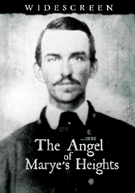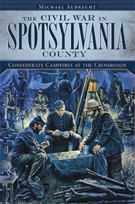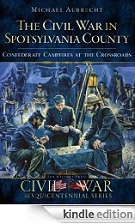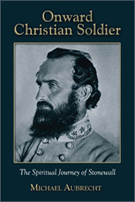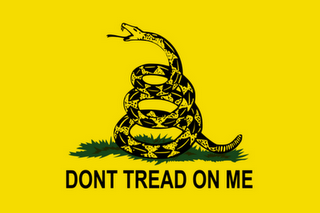BLOG, or DIE. Author Bio
Monday, 8 March 2010
Jefferson and Jesus
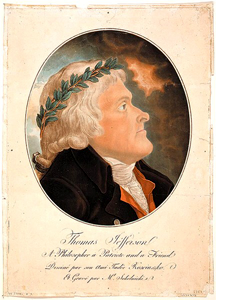 I am a Christian, in the only sense in which he [Christ] wished anyone to be; sincerely attached to his doctrines, in preference to all others; ascribing to himself every human excellence; and believing he never claimed any other. - Thomas Jefferson to Benjamin Rush, April 12, 1803
I am a Christian, in the only sense in which he [Christ] wished anyone to be; sincerely attached to his doctrines, in preference to all others; ascribing to himself every human excellence; and believing he never claimed any other. - Thomas Jefferson to Benjamin Rush, April 12, 1803
Without a doubt, one of the most complex aspects of Thomas Jefferson’s life story is the subject of spirituality. From his authoring of the Virginia Statute of Religious Freedom and Jefferson Bible, to the many letters that he sent to friends and associates touting the teachings of Jesus Christ, Jefferson’s religious beliefs remain a perplexing riddle to this very day.
As a practicing Christian and historian, I have spent a great deal of time examining this subject and my dream of penning that best-seller revolves around a book that presents Jefferson’s experiences here in Fredericksburg when he agreed to draft the official document that separated church and state. A recurring interest, Jefferson’s attitudes on faith were the focus of the inaugural essay that I wrote for The Jefferson Project, as well as the initial debate that I participated in at Jefferson Today.
Below is a portion of my rebuttal from Jefferson Today. You can also read my essay, titled Jefferson’s Religious Freedom, over at The Jefferson Project. Plans are to open this subject up for discussion in a future posting, while providing additional insights and sources from the Thomas Jefferson Foundation.
CHRISTIAN CONSCIENCE?
Jefferson rejected the “divinity” of Jesus, but he believed that Christ was a deeply interesting and profoundly important moral or ethical teacher. He also subscribed to the belief that it was in Christ’s moral and ethical teachings that a civilized society should be conducted. Cynical of the miracle accounts in the New Testament, Jefferson was convinced that the authentic words of Jesus had been contaminated. His theory was that the earliest Christians, eager to make their religion appealing to the pagans, had obscured the words of Jesus with the philosophy of the ancient Greeks and the teachings of Plato. These so-called “Platonists” had thoroughly muddled Jesus’ original message. Firmly believing that reason could be added in place of what he considered to be “supernatural” embellishments, Jefferson worked tirelessly to compose a shortened version of the Gospels titled “The Philosophy of Jesus of Nazareth.” The subtitle stated that the work was “extracted from the account of his life and the doctrines as given by Matthew, Mark, Luke & John.”
On April 21, 1803, Jefferson sent a letter to Dr. Benjamin Rush, who was a fellow ‘Founding Father’ and devout Christian, explaining his own interpretation of scripture.
Dear Sir,
In some of the delightful conversations with you in the evenings of 1798-99, and which served as an anodyne to the afflictions of the crisis through which our country was then laboring, the Christian religion was sometimes our topic; and I then promised you that one day or other I would give you my views of it. They are the result of a life of inquiry and reflection, and very different from that anti-Christian system imputed to me by those who know nothing of my opinions. To the corruptions of Christianity I am indeed opposed, but not to the genuine precepts of Jesus himself. I am a Christian, in the only sense in which he wished anyone to be: sincerely attached to his doctrines in preference to all others, ascribing to himself every human excellence, and believing he never claimed any other. At the short interval since these conversations, when I could justifiably abstract my mind from public affairs, the subject has been under my contemplation. But the more I considered it, the more it expanded beyond the measure of either my time or information. In the moment of my late departure from Monticello, I received from Dr. Priestley his little treatise of “Socrates and Jesus Compared.” This being a section of the general view I had taken of the field, it became a subject of reflection while on the road and unoccupied otherwise. The result was, to arrange in my mind a syllabus or outline of such an estimate of the comparative merits of Christianity as I wished to see executed by someone of more leisure and information for the task than myself. This I now send you as the only discharge of my promise I can probably ever execute. And in confiding it to you, I know it will not be exposed to the malignant perversions of those who make every word from me a text for new misrepresentations and calumnies. I am moreover averse to the communication of my religious tenets to the public, because it would countenance the presumption of those who have endeavored to draw them before that tribunal, and to seduce public opinion to erect itself into that inquisition over the rights of conscience which the laws have so justly proscribed. It behooves every man who values liberty of conscience for himself, to resist invasions of it in the case of others; or their case may, by change of circumstances, become his own. It behooves him, too, in his own case, to give no example of concession, betraying the common right of independent opinion, by answering questions of faith which the laws have left between God and himself. Accept my affectionate salutations.
- Th: Jefferson
IMAGE: Thomas Jefferson, aquatint by Tadeusz Koo Ciuszko

Friday, 5 March 2010
Revisiting a Massacre
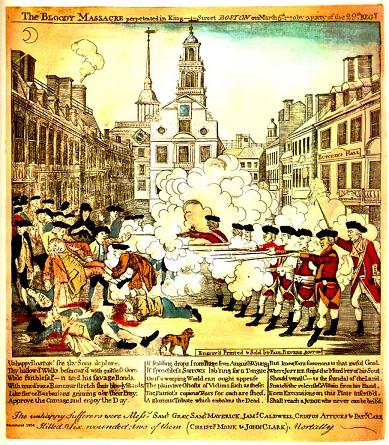
Today is the anniversary of one of the most significant dates in our nation’s history...March 5, 1770: A contingent of armed British soldiers fire into a crowd of protesting colonists in what will become known as the Boston Massacre. Five colonists are killed. The soldiers, charged with murder, will contend the protestors were threatening them with rocks and clubs. The killings will spark public outrage, demands for the death penalty for the soldiers responsible, and draw America even closer toward revolution. Ironically, patriot and future U.S. President John Adams is the lawyer who will successfully defend the British soldiers. A portion of Adams’ argument reads: “Facts are stubborn things; and whatever may be our wishes, our inclinations, or the dictates of our passions, they cannot alter the state of facts and evidence: nor is the law less stable than the fact; if an assault was made to endanger their [the soldiers’] lives, the law is clear, they had a right to kill in their own defense.” Text courtesy of Mark Jones, friend and historical-date-referencing extraordinaire.
On a related note, this afternoon I was contacted by Julio Torres, an intern from the Oxford University Press, who directed me to a very thought-provoking and unique post by Alan Archer, author of AS IF AN ENEMY’S COUNTRY, that explores the Boston Massacre with a contemporary perspective that remains thoughtful of current military events. Enjoy. ABOVE: Engraving by Paul Revere.

Saturday, 27 February 2010
NOT Black Confederates
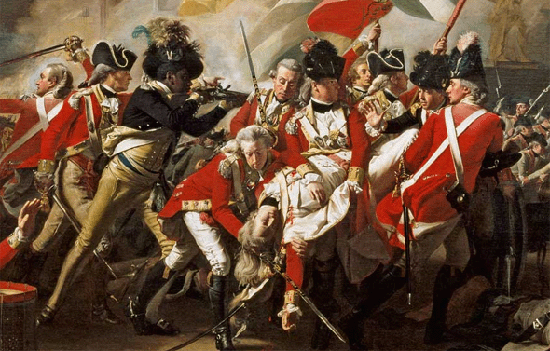
ABOVE: A cropping of The Death of Major Peirson by John Singleton Copley (Image © Tate, London 2008.) The artist painted a black soldier not present at the battle, wearing the uniform of a Royal Ethiopian. Copley knew of the Royal Ethiopian Regiment before his loyalty forced him to flee Boston. It is telling that he chose to include a Royal Ethiopian soldier in a battle at which the regiment never fought. As Black History Month comes to an end, I can't think of a better post to share today than the extraordinary story of the "Black Loyalists in New Brunswick." Without a doubt, one of the most highly controversial and contested subjects in today's historical studies (both in the public and academic arena) is the questionable history of Black "Confederates" during the American Civil War. In recent months this subject has been debated ad nauseum across the blogosphere and I touched on the subject in my recent book on Confederate encampments in Spotsylvania County.
The quarrel of course is why anyone would willingly take up arms on behalf of a cause that sought to keep them in bondage - vs. - the notion that many Africans fought beside their masters in order to protect their state's from Federal occupation. Those of you who read Campfires at the Crossroads may recall that I found the examples of black Confederates whom I cited to be slaves acting in the capacity of servants, not soldiers. The letters that I included testified to that conclusion.
Although that argument will continue for generations it seems, America's first revolution did, IN FACT, find blacks fighting alongside their white counterparts.
At the time of the Revolutionary War (1775-1783), it is estimated that there were over a half million African-Americans living in the thirteen colonies. As the rebellion's patriotic call to fight for liberty grew, the British government sought to undermine the expanding Continental Army by soliciting slaves who ran away from their masters. By promising to grant them their freedom and security, the Redcoat ranks were able to boost their manpower on the battlefield instead of constantly relying on the importation of additional troops who took months to travel to the Americas from England. Some of these all-black units even flourished as in the example of the Royal Ethiopian Regiment and later, the Black Pioneers.
According to the Atlantic Canada Virtual Archives website Black Loyalists in New Brunswick: "In November 1775, Virginia Governor Lord Dunmore, hoping to bolster the British war effort, encouraged slaves and indentured servants of the Patriots to join His Majesty's army. Many did so. When the British evacuated their army from Boston to Halifax in 1776, a "Company of Negroes" was part of the entourage. British Commander-in-Chief Sir Henry Clinton extended the policy of appealing to African Americans in his Phillipsburg Proclamation of 1779 in which he offered security behind British lines to 'every negro who shall desert the Rebel Standard.'"
Following the British Army's surrender, it is estimated that nearly 35,000 loyalists fled the United States to settle north in the provinces of Canada including the maritime regions of New Brunswick and Nova Scotia. Nearly 3,500 free black loyalists were among them including many who had fought alongside the Redcoats on behalf of the English crown. New Brunswick saw thousands of African-Americans settle in as new citizens and many went on to fight again for Britain in the War of 1812. Despite their service to the king, many black loyalists and their families still faced racial discrimination, although it paled in comparison to the institution of slavery that continued to thrive in the southern United States.
For a complete history, visit Black Loyalists in New Brunswick 1783-1854. This outstanding project is a digital collection hosted by the Atlantic Canada Virtual Archives and features document and petition transcripts, rare images, as well as lesson plans and resources for teachers.

Friday, 26 February 2010
A grand old flag
As my studies of the American Revolution continue to evolve, I find myself becoming fascinated with the flags that were used to rally both citizens and soldiers to the pursuit of liberty. The title of this blog for instance, comes from the famous “Join, or Die.” flag, based on a well-known political cartoon, created by Benjamin Franklin and first published in his Pennsylvania Gazette in May of 1754. Another flag that has caught my fancy is the “Don’t Tread on Me,” otherwise known as the Gadsden flag.
That standard in particular has become a popular symbol of Americana. I have both of these banners hanging in my cubicle at work and have seen them plastered on everything from t-shirts to bumper stickers. Those of you familiar with my editorials on the Confederate flag know that I’ve never been a fan of flags being turned into imagery on merchandise. That said, I do find it interesting that we have embraced the spirit of the Gadsden flag and made it a modern brand. It has been woven into the fabric of our culture and today we fly “Don’t Tread on Me” in celebration of our past and in dissatisfaction with our own government.
The Gadsden flag was designed by and is named after the general and statesman from South Carolina named Christopher Gadsden. In 1775, the then Colonel Gadsden, presented his design to the Continental Congress to be used as a standard by the commander of the navy. The image was immediately striking with a bright, yellow field, a graphical representation of a rattlesnake in the posture of striking, and the words "Don't Tread on Me” underneath.
As the fight for independence grew closer, the snake began to be used frequently as a symbol of the colonies and their cause. It appears on several variations of flags and one of its biggest champions, Benjamin Franklin, published an essay under the pseudonym “American Guesser,” in which he suggested that the rattlesnake was a perfect match for the American spirit. He wrote:
I recollected that her eye excelled in brightness, that of any other animal, and that she has no eye-lids—She may therefore be esteemed an emblem of vigilance.—She never begins an attack, nor, when once engaged, ever surrenders: She is therefore an emblem of magnanimity and true courage.—As if anxious to prevent all pretensions of quarreling with her, the weapons with which nature has furnished her, she conceals in the roof of her mouth, so that, to those who are unacquainted with her, she appears to be a most defenseless animal; and even when those weapons are shewn and extended for her defense, they appear weak and contemptible; but their wounds however small, are decisive and fatal:—Conscious of this, she never wounds till she has generously given notice, even to her enemy, and cautioned him against the danger of treading on her.—Was I wrong, Sir, in thinking this a strong picture of the temper and conduct of America? (Source: Franklin, Benjamin. Pennsylvania Journal. December 27, 1775)
Chris Whitten, a fellow Libertarian and Internet entrepreneur, has developed an excellent web site that deals with the complete histories of Christopher Gadsden , the Gadsden flag, and how his snake image is celebrated in our modern culture.
BELOW: Gadsden variation used by the 6th North Carolina Continental Line Regiment. (Photo by Me. "A Day in the Life of Spotsylvania," Belvedere Plantation, 2007.)
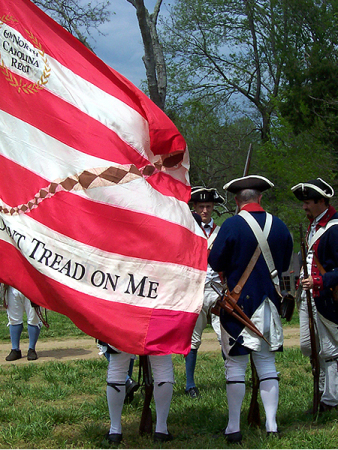
Posted by ny5/pinstripepress
at 10:01 AM EST
Updated: Saturday, 27 February 2010 3:39 PM EST
Permalink |
Share This Post

Tuesday, 23 February 2010
A whirlwind of writing activity
Yesterday I completed my talk and slide show for the Virginia Farm Bureau Women’s Conference Brunch on “Mary Ball Washington: Mother of the Father of our Country.” This 30-minute speech was a real challenge, but I went the extra mile on research and came up with what I think is a very solid portrait of a very complex woman. As this is to be considered a Sunday morning “devotional”, I had to write an opening prayer and find a balance between portraying Mary through a religious and secular narrative. After two drafts I was able to find a nice balance in which I present a fairly standard history lesson, while referring to documented interpretations of Mary’s spiritual-side. I enjoyed the prep-work on this one immensely and although I state no personal assumptions in my speech, I personally believe that Mary was a strong-willed and stubborn woman with a deep sense of faith.
Following the March 21 engagement, I will be sending a modified (and more scholarly) version to the folks at Patriots of the American Revolution for publication in an upcoming issue of their magazine. Last week I compiled some excellent reference for my article on George Washington and the VA Militia in western Pennsylvania, and I finally started reading Jefferson at War for an upcoming PAR book review requested by our friend Eric Wittenberg. As I will be focusing much of my time and energy on these larger pieces, I plan to post some shorter ones here on my blog. Upcoming topics include: Tar and Feathering and Loyalists. As you may have noticed, the new mantra here at “Blog, or Die.” is quality – not quantity. Stay tuned…
Posted by ny5/pinstripepress
at 11:52 AM EST
Updated: Tuesday, 23 February 2010 11:57 AM EST
Permalink |
Share This Post

Newer | Latest | Older
 I am a Christian, in the only sense in which he [Christ] wished anyone to be; sincerely attached to his doctrines, in preference to all others; ascribing to himself every human excellence; and believing he never claimed any other. - Thomas Jefferson to Benjamin Rush, April 12, 1803
I am a Christian, in the only sense in which he [Christ] wished anyone to be; sincerely attached to his doctrines, in preference to all others; ascribing to himself every human excellence; and believing he never claimed any other. - Thomas Jefferson to Benjamin Rush, April 12, 1803